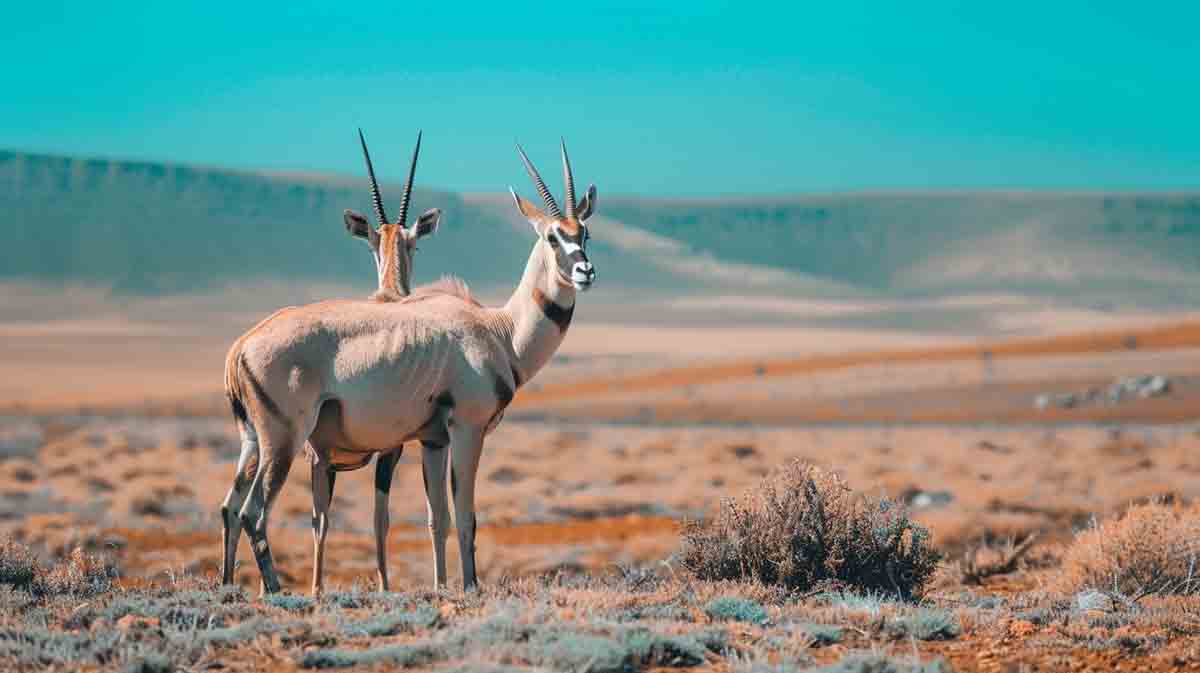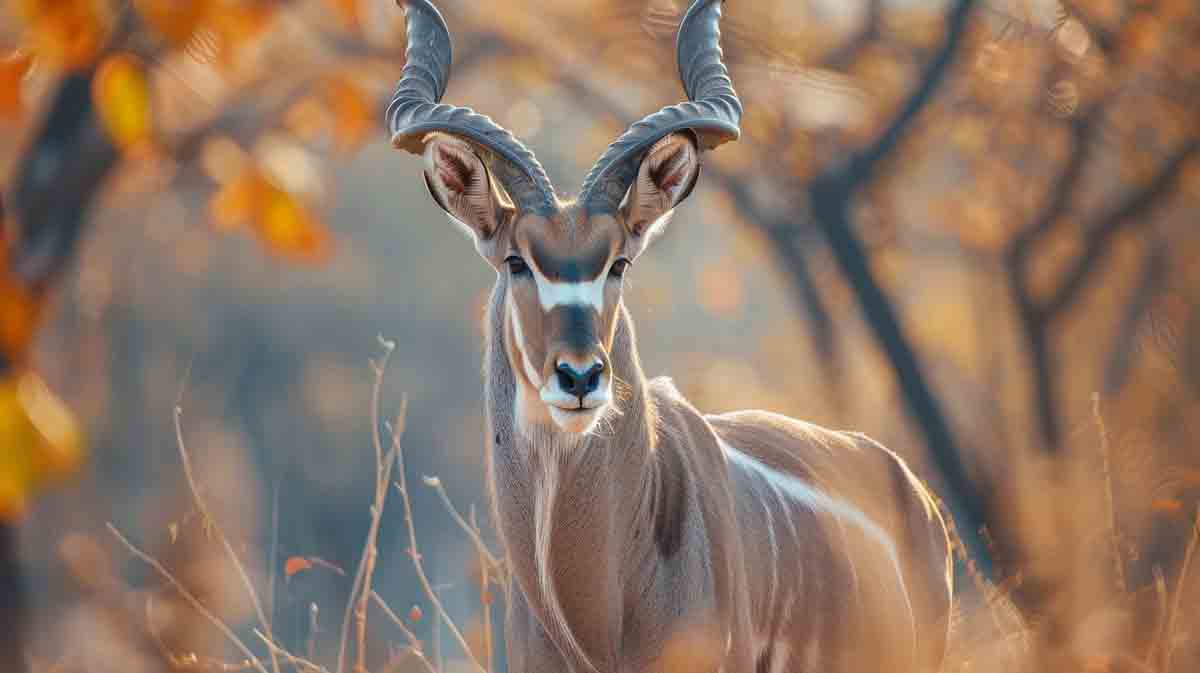Did you know that Southern Africa is home to over 70 different species of antelopes? With their stunning horns and unique adaptations, these graceful creatures roam the vast savannas and woodlands, contributing to the region’s rich wildlife diversity. This article will delve into the fascinating world of African antelopes, uncovering their incredible species, habitat, behaviour, and conservation status. Join us on this journey to discover the captivating wildlife facts of southern Africa.
Key Takeaways:
- Africa is home to many antelope species, with over 70 different types in Southern Africa alone.
- African antelopes exhibit diverse physical characteristics, behaviours, and adaptations to thrive in their respective habitats.
- Habitat loss, poaching, and human-wildlife conflict pose significant threats to the conservation of antelope species in African ecosystems.
- Antelopes play a vital role in African ecosystems, contributing to the balance of plant populations and serving as a food source for predators.
- Conservation efforts and initiatives are crucial for protecting and preserving the diverse antelope species in Southern Africa.
Overview of Antelope Species in Africa
Africa is home to many beloved and recognisable antelope species. The most popular ones include the impala, kudu, eland, and nyala. These African antelope species can be found in various habitats across Southern Africa and are known for their distinct physical characteristics and grazing patterns. They are an integral part of the African ecosystem, providing food for predators and contributing to the balance of nature.

Popular African Antelope Species
Among the popular African antelope species are:
- Impala
- Kudu
- Eland
- Nyala
These antelopes are renowned for their beauty and grace. They capture safari-goers with impressive horns, striking colours, and agile movements.
Habitat and Distribution of Antelopes in Southern Africa
Antelopes in Southern Africa inhabit many habitats, including open savannas, woodlands, and even deserts. Each species has its preferred habitat and distribution and adapts to different environmental conditions.
For example, the kudu is found in wooded areas and open grasslands, while the oryx thrives in arid desert regions. Understanding their habitat preferences and distribution is crucial for their conservation.
Behaviour and Grazing Patterns of African Antelopes
One of the fascinating aspects of African antelope behaviour is their social nature. Most antelopes are social animals, living in herds and communicating with each other using various sounds and scent signals.
These herbivores graze on grass or browse on leaves and fruits, and the availability of food and water often influences their feeding patterns. Some antelopes, like the impala, are known for their leaping abilities, while others, like the eland, are skilled jumpers.

Conservation Status of Antelope Species in Africa
Unfortunately, many antelope species in Africa are facing threats to their survival. Habitat loss, poaching, and human-wildlife conflict are some of the challenges they encounter.
The conservation status of different antelope species varies, with some listed as endangered or vulnerable. Conservation efforts are crucial to protecting these species and their habitats, and various initiatives are in place to safeguard their populations.
Role of Antelopes in African Ecosystems
Antelopes play a vital role in African ecosystems. As herbivores, they help maintain the balance of plant populations by grazing on grasses and browsing on vegetation.
Their feeding habits influence the structure and composition of plant communities, shaping the landscape for other species. Additionally, antelopes serve as an essential food source for predators such as lions and cheetahs.
By conserving African antelopes, we contribute to the overall biodiversity and health of African landscapes, ensuring the long-term sustainability of African antelope ecosystems.
Exploring Southern Africa’s Unique Antelope Species

Southern Africa is home to some iconic antelope species, including the eland and kudu. The eland, the largest antelope in the world, can be found in various habitats, from savannas to woodlands. It is known for its distinctive shoulder hump and tightly spiralled horns. On the other hand, the kudu is recognised for its majestic horns and can be spotted in open grasslands and wooded areas. These unique antelope species offer thrilling encounters during safaris in Southern Africa.
Endangered Antelopes in Southern Africa
Unfortunately, several antelope species in Southern Africa are endangered or at risk of extinction. Habitat loss resulting from human activities, such as agriculture and urban development, poses a significant threat. Illegal poaching, driven by the demand for traditional medicine and the commercial wildlife trade, further exacerbates the decline in antelope populations. Examples of endangered antelopes in the region include the sable antelope and roan antelope. It is crucial to implement conservation efforts, such as establishing protected areas and anti-poaching measures, to safeguard these endangered species and secure their survival for future generations.
Diversity of Small to Medium-Sized Antelope Species
The diversity of antelope species in Southern Africa extends beyond the iconic eland and kudu. The region is also populated by many small to medium-sized antelopes, including the bushbuck, duiker, and steenbok. Each species possesses unique physical characteristics and exhibits distinct habitat preferences. This rich variety of antelope species contributes to the overall biodiversity of the region and offers captivating wildlife viewing opportunities for nature enthusiasts.
Distinctive Features: Horns and Physical Characteristics
One of the most remarkable aspects of antelopes is their horns. These magnificent animals showcase various types of horns, ranging from straight to curved or spiralled. Horns may be exclusive to males or present in males and females, depending on the species. In addition to horns, antelopes have evolved specific physical characteristics and behaviours that enable them to thrive in their respective habitats. These adaptations play a crucial role in their survival and ability to navigate the challenges of the wild.

The Relationship Between Antelopes and Predators
The predator-prey relationship between antelopes and their natural predators is integral to the African ecosystem. Antelopes are a vital food source for predators such as lions, leopards, and cheetahs. These predators specifically target antelopes during hunting and feeding. However, antelopes have developed survival strategies and adaptations to evade and defend themselves against predators. With their keen senses and powerful horns, antelopes are equipped to withstand the challenges posed by their predators. This dynamic interaction contributes to the balance and functioning of the African ecosystem.
Preserving Wildlife: Conservation Efforts and Challenges
Antelope species in Southern Africa face numerous threats that jeopardise their survival. Habitat loss, primarily due to agriculture and urban development, poses a significant concern for these majestic creatures. In addition, illegal poaching for their horns and skin remains a significant threat driven by the demand for traditional medicine and the commercial wildlife trade. Climate change and human-wildlife conflict also challenge antelope conservation efforts in the region. More robust conservation measures and increased community engagement are essential to protecting these magnificent species.
Conservation Initiatives and Wildlife Protection
Southern Africa is home to several conservation initiatives and organisations devoted to safeguarding antelope species. These efforts focus on establishing and managing protected areas, implementing anti-poaching measures, and promoting sustainable wildlife tourism. The success of these endeavours relies on collaborative partnerships between governments, conservationists, and local communities. Education and awareness programs significantly emphasise the value of antelope species and cultivate a sense of stewardship among local communities.
Human-Antelope Conflict: Impact on Conservation
Human-antelope conflict arises when human activities intersect with antelope habitats and behaviour. Such conflicts often occur where human settlements and agricultural activities are near antelope habitats. Crop damage, livestock predation, and resource competition can lead to negative interactions between humans and antelopes. Conserving antelope species requires effective management of this conflict and finding ways to mitigate its impact on human livelihoods and antelope conservation. This challenge necessitates collaboration between conservationists and local communities.
Success Stories: Rescuing Endangered Antelope Populations
Despite the challenges facing Southern African antelope species, there have been notable success stories in rescuing and protecting endangered populations. Various organisations and conservationists have implemented captive breeding programs, translocation efforts, and habitat restoration projects to increase the numbers and genetic diversity of endangered antelope species. These initiatives have resulted in the recovery of populations and conserving these species for future generations. These success stories testify to the positive impact of conservation and inspire continued efforts to protect antelope species.

Future Prospects: Sustainability and Long-Term Conservation Strategies
Achieving long-term conservation of antelope species in Southern Africa demands sustainable practices and comprehensive strategies. This includes maintaining and expanding protected areas, strengthening legislation and law enforcement to combat wildlife crime, promoting community engagement and eco-tourism, and addressing the underlying causes of habitat loss and human-wildlife conflict. Collaborative efforts between governments, conservation organisations, local communities, and the tourism industry are critical in ensuring the region’s continued survival and well-being of antelope species.
FAQ
What are some common antelope species found in Southern Africa?
Some common antelope species found in Southern Africa include eland, sable, kudu, duiker, impala, waterbuck, roan, oryx, steenbok, bushbuck, gemsbok, nyala, and hartebeest.
Where can I find different species of antelope in South Africa?
South Africa has various antelope species, including the sable antelope, roan antelope, hartebeest, common eland, and many others.
What are some characteristics of the eland species of antelope?
The eland is a large antelope with distinct spiral-structured horns and is known for its ability to adapt to various environments, making it one of the most widespread antelopes in Africa.
Do all species of antelope have horns?
Not all species of antelope have horns, but many males in these species possess distinct horns used for defence and mating competition.
Where do waterbuck, gemsbok, and hartebeest commonly reside?
Waterbuck, gemsbok, and hartebeest are often found in southern and Eastern Africa’s savannas, grasslands, and woodlands.
Are there any specific physical traits that distinguish different species of antelope?
Different antelope species have unique physical traits, such as horn shape, size, colouration, and body markings, that distinguish them.
What is the fastest antelope species, and where is it found?
The cheetah is the fastest antelope species, and it is found in the African savanna, particularly in areas with open grasslands for swift hunting.
Do antelope species exhibit sexual dimorphism in terms of horn development?
Yes, in many antelope species, the males possess more prominent and elaborate horn structures than the females, which they use for territorial dominance and mating displays.
What are some of the favourite antelope species for wildlife enthusiasts?
Favourite antelope species often include the kudu, impala, and majestic gemsbok, cherished for their striking appearances and behaviours in the wild.
How do different antelope species contribute to the ecosystems they inhabit?
Antelope species play a crucial role in shaping the structure and dynamics of their respective ecosystems by influencing vegetation through grazing, serving as prey for predators, and contributing to the overall biodiversity of the region.
